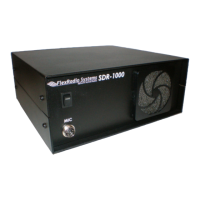O P E R A T I O N C H A P T E R 1 0
Figure 137: MixW Serial Port Details
5. Set the Port to COM16, RTS to CW and DTR to PTT. Click OK on this form and the previous
form.
6. Change the mode in MixW to CW. Click on the TX button on MixW’s main panel. It should key
PowerSDR without generating a tone. Click RX in MixW and PowerSDR should return to receive.
If you have entered your callsign in MixW, click on the CQ button. It should key the radio and
produce Morse code calling CQ with your call sign. Verify with the TX Meter (4) set to Fwd Pwr
that there is forward power.
7. You are now ready to begin a QSO. If a 50 ohm dummy load was connected, connect an antenna in
its place. Tune to the desired frequency using one of the methods outlined in the Tuning Methods
section above. Select either CWL or CWU (6) and proceed with the QSO.
Note: CW VFO Frequency Offset
The VFO on the PowerSDR software is designed to show the zero beat of
the CW tone using the selected CW Pitch. For this reason, when in the
CW Modes, the center zero line is actually offset by the CW Pitch
frequency. This allows click-tuning of CW signals as well as the
traditional CW VFO readout. This also enables the VFO to remain
constant when switching from CWL to CWU mode. Every effort possible
is made to preserve a CW signal when switching between any SSB and
CW modes.
[The rest of this page has been left blank intentionally]
143 FlexRadio Systems

